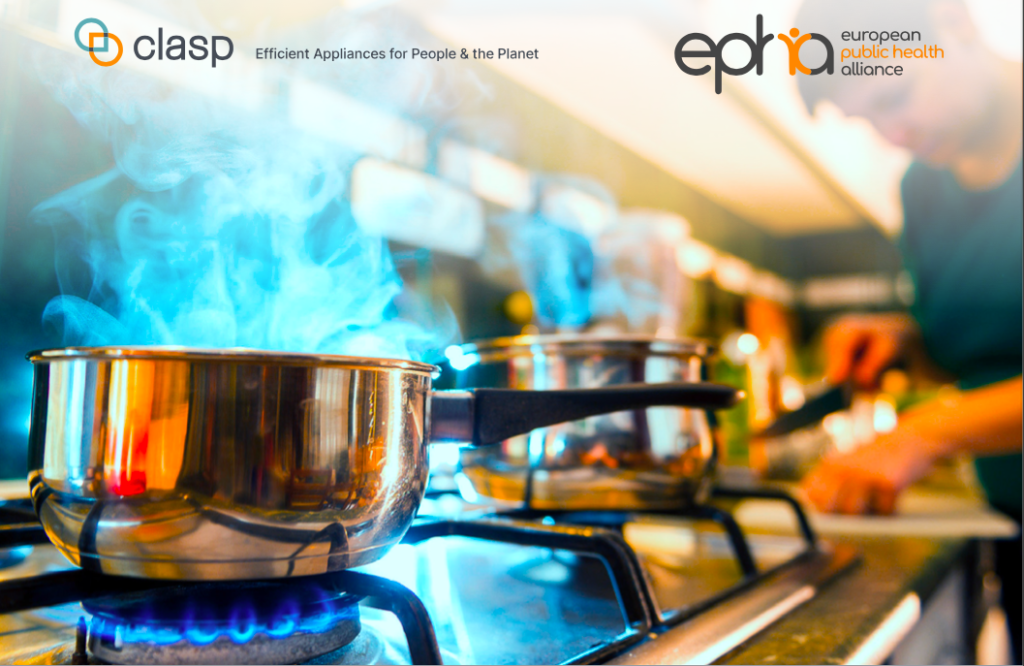
Cooking with gas produces indoor air pollution which negatively impacts our health. European policy measures and interventions are required to protect public health
Executive Summary
Findings
All gas cooking appliances release pollutants that are harmful to human health and the environment. With new research, this report synthesises the health risks of cooking with gas, quantifies the societal cost, and gives actionable solutions to phase out gas cooking appliances across the EU-27, in favour of electric alternatives. The findings are summarised here:
Cooking with gas releases hazardous air pollutants into our homes. Cooking on gas appliances may be exposing over 100 million people in Europe to levels of indoor air pollution that would violate EU outdoor air pollution regulations. Gas cooking appliances emit NO2. There is documented association between NO2 exposure and the development of asthma in children. Gas cooking also emits carbon monoxide, carbon dioxide, and unburned methane, which can languish indoors after appliance use.
Indoor air pollution from gas cooking harms people. The European Environment Agency recognises air pollution as the biggest environmental health risk in Europe. Over 700,000 children in the EU have suffered asthma symptoms in the last year due to cooking on gas. 12% of current paediatric asthma cases could be avoided if gas cookers were removed from EU homes. There is growing evidence linking combustion-related air pollution with adverse effects on brain development in young children. For adults, pollutants from gas cooking can lead to negative impacts on the brain, respiratory, and nervous systems.
Gas is not ‘natural’ or ‘clean.’ The gas industry has invested heavily in positioning cooking with gas as a safe and preferred option. In part because of these efforts, people are widely unaware of the health and environmental risks posed by gas cooking, which are well documented through decades of research.
Cooking with gas is costly. Indoor air pollution from gas cooking is estimated to cost the EU €3.5 billion annually in healthcare costs, lost earnings and productivity, and disability adjusted life years (DALY). Cleaner electric alternatives are already available at similar or lower cost. Government incentives for electric technologies would yield five to 16 times return on investment in terms of healthcare costs.
Ventilation is not enough. Range hoods aren’t always turned on and may not be completely effective when used. Recirculation hoods — common in apartments — are aimed at odour removal and hardly remove NO2, a primary pollutant of concern. Overall, vents are often ineffective, insufficient or underused.
Gas cooking undermines EU targets to become a climate-neutral economy by 2050. As a fossil fuel, cooking gas emits environmental pollutants like methane, benzene, and CO2. Even when switched off, gas cooking appliances leak methane — a potent greenhouse gas.
Gas cooking undermines the EU’s electrification and efficiency agendas. There are significant EU-wide efforts to increase efficiency of homes and buildings. Unfortunately, the more energy-efficient and well insulated a building, the worse the indoor air pollution from gas cooking if ventilation is inadequate. Energy efficiency and electrification efforts should go hand-in-hand, not undermine each other. Switching from gas to electric cooking during a building upgrade will improve the indoor air quality of a household.
Clean hydrogen is not a viable cooking fuel. Piping hydrogen into homes would require significant time and investment. Mixing hydrogen with methane changes the chemistry of the fuel, which can affect burner performance and decrease efficiency. Gas cookers would also likely need to be adapted or entirely replaced to function properly with hydrogen fuel. Testing performed for this study found that mixing hydrogen with gas can increase levels of pollutants that are harmful to human health
Recommendations
EU policy does not protect people from the dangers of gas cooking. Despite the evidence, and unlike for cigarettes and cars, there are no warning labels for gas cooking appliances explaining their risks or pollutant emissions. There are no EU-wide or Member State policies in place that sufficiently mitigate the health and environmental risks of gas cooking. This report recommends that groups implement the following actions to change this:
■ The EU Commission should adopt laws protecting households from harm, specifically by setting pollutant limits in the upcoming review of Ecodesign requirements on Domestic Cooking Appliances. The Commission should also communicate to the public about gas cooking hazards through the Energy Label and other means.
■ Member State and local governments should vote in favour of people- and planet-conscious regulations, including incentivising efforts to accelerate the transition to electric cooking and full home electrification.
■ Health professionals should increase public awareness about the link between gas cooking and health, and support actions to mitigate harm.
■ Individuals should protect their health by making the switch from gas to electric cooking alternatives, such as induction hobs and plug-in appliances, whenever possible. People can also commit to proper ventilation and install a low-level carbon monoxide detector.
Original publication of entire report: Hannah Blair, Nicole Kearney, Cristina Pricop, Michael Scholand, Exposing the Hidden Health Impacts of Cooking with Gas, CLASP and European Public Health Alliance, January 2023, bit.ly/3pl72Fm
This Commentary includes only the Executive Summary.


No comments yet, add your own below